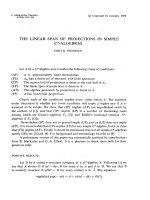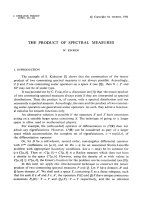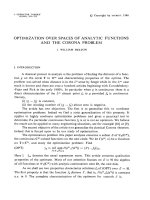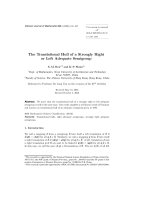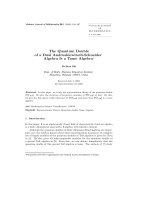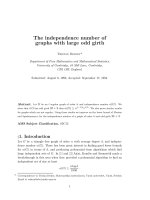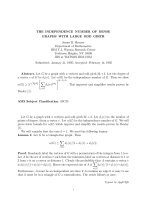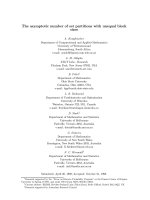Báo cáo toán học: "The Last Digit of 2n n and n 2n−2i i n−i" ppsx
Bạn đang xem bản rút gọn của tài liệu. Xem và tải ngay bản đầy đủ của tài liệu tại đây (114.97 KB, 8 trang )
TheLastDigitof
2
n
n
and
n
i
2
n−
2
i
n−i
Walter Shur
11 Middle Road
Port Washington, NY 11050
wshur @ worldnet.att.net
Submitted: June 28, 1996; Accepted: November 11, 1996.
AMS subject classification (1991): Primary 05A10; Secondary 11B65.
Abstract
Let f
n
=
n
i=0
n
i
2n−2i
n−i
, g
n
=
n
i=1
n
i
2n−2i
n−i
.Let{a
k
}
k=1
be the set of all
positive integers n, in increasing order, for which
2n
n
is not divisible by 5, and
let {b
k
}
k=1
be the set of all positive integers n, in increasing order, for which
g
n
is not divisible by 5. This note finds simple formulas for a
k
, b
k
,
2n
n
mod 10,
f
n
mod 10, and g
n
mod 10.
Definitions
f
n
=
n
i=0
n
i
2n−2i
n−i
; g
n
=
n
i=1
n
i
2n−2i
n−i
{a
k
}
k=1
is the set of all positive integers n, in increasing order, for which
2n
n
is not divisible by 5.
{b
k
}
k=1
is the set of all positive integers n, in increasing order, for which g
n
is not divisible by 5.
u
n
is the number of unit digits in the base 5 representation of n .
the electronic journal of combinatorics 4 (no. 2), #R16 2
Theorem 1. a
k
is the number in base 5 whose digits represent the number k
in base 3. If n ≥ 1,
2n
n
mod 10 =
0 if n ∈ {a
k
}
2
4
6
8
if n ∈{a
k
}and u
n
mod 4=
1
2
0
3
.
Note that if n ∈{a
k
},u
n
is odd (even) if and only if n is odd (even).
Proof. From Lucas’ theorem [1], we have
2n
n
≡
N
1
n
1
N
2
n
2
···
N
t
n
t
mod 5,
where 2n =(N
r
···N
3
N
2
N
1
)
5
, n=(n
s
···n
3
n
2
n
1
)
5
,andt=min(r, s).
Suppose that for each i ≤ t, n
i
≤ 2. Then, for each i ≤ t, N
i
=2n
i
.Since
n
i
=0,1 or 2, each term of the product
N
1
n
1
N
2
n
2
···
N
t
n
t
is 1, 2 or 6. Hence,
2n
n
is not divisible by 5.
Suppose that for some i, n
i
> 2. Let i
m
be the smallest value of i for
which that is true. Then, if n
i
m
is3or4,N
i
m
is1or3(resp.).Ineithercase,
N
i
m
n
i
m
=0,and
2n
n
is divisible by 5.
Thus, {a
k
} is the set of all positive integers written in base 3, but interpreted
as if they were written in base 5. Since {a
k
} is in increasing order, the first
part of the theorem is proved.
Suppose now that
2n
n
is not divisible by 5. Then each term of the product
N
1
n
1
N
2
n
2
···
N
t
n
t
is 1, 2or6(accordingasn
i
=0,1,or2). We have, noting that
2n
n
is even,
2
u
n
mod 10 = 6
†
, 2, 4or8,
N
1
n
1
N
2
n
2
···
N
t
n
t
mod 10 = 6, 2, 4or8,
2n
n
mod 10 = 6, 2, 4or8,
according as u
n
mod 4=0,1,2or3.
the electronic journal of combinatorics 4 (no. 2), #R16 3
Corollary 1.1.
a
k
= k +2
i=1
k
3
i
5
i−1
.
Proof. Let k =(···d
3
d
2
d
1
)
3
, and consider a
k
=
i=1
d
i
5
i−1
.
d
1
= k − 3
k
3
d
2
=
k
3
− 3
k
3
2
d
3
=
k
3
2
− 3
k
3
3
.
.
.
.
.
.
.
.
.
Therefore,
i=1
d
i
5
i−1
=
i=1
k
3
i−1
− 3
k
3
i
5
i−1
.
Since
k
3
i
5
i
−3
k
3
i
5
i−1
=2
k
3
i
5
i−1
, the corollary is proved.
Corollary 1.2. Let µ
k
be the largest integer t such that k/3
t
is an integer.
Then,
a
k
− a
k−1
=
5
µ
k
+1
2
,anda
k
=1+
k
i=2
5
µ
i
+1
2
.
µ
k
=mif and only if k ∈{j3
m
},where j is a positive integer and jmod3=
0.
Proof. If µ
k
> 0, then
k =(···d
µ
k
+1
0 ···0)
3
; d
µ
k
+1
≥ 1; and k −1=(···(d
µ
k
+1
−1)2 ···2)
3
.
Hence,
a
k
−a
k−1
=5
µ
k
−2[5
µ
k
−1
+5
µ
k
−2
+···+1]=
5
µ
k
+1
2
.
†
Equals 1 if u
n
= 0; nevertheless, the next line follows since, if u
n
=0,at least one n
i
must equal
2, making
2n
i
n
i
=6.
the electronic journal of combinatorics 4 (no. 2), #R16 4
If µ
k
=0,then
k=(···d
1
)
3
; d
1
≥1; and k − 1=(···(d
1
−1))
3
.
Hence,
a
k
−a
k−1
=1=
5
µ
k
+1
2
.
The remaining parts of the corollary follow immediately.
Corollary 1.3. If k>1,
a
k
=
5a
k
3
if kmod3=0,
a
k−1
+1 if kmod3=0.
Proof. If kmod3=0,then k =(···d
2
0)
3
and
k
3
=(···d
2
)
3
.Hence, a
k
=5a
k
3
.
If kmod3=0, then µ
k
= 0 and from Corollary 1.2, we have a
k
− a
k−1
=1.
Theorem 2. b
k
isthenumberinbase5whosedigitsrepresentthenumber
2k−1in base 3, i.e. b
k
= a
2k−1
.Furthermore,g
n
mod 10 canonlytakeonthe
values 1,5 or 9, as follows:
g
n
mod 10 =
5 if n ∈ {b
k
}
1
9
if n ∈{b
k
}and u
n
mod 4=
1
3
.
Proof. Let F (z)=
n
f
n
z
n
=
n
z
n
i
n
i
2n − 2i
n −i
.
Letting t=n-i, we have
the electronic journal of combinatorics 4 (no. 2), #R16 5
F(z)=
n
z
n
t
n
t
2t
t
=
t
2t
t
n
n
t
z
n
=
1
1 − z
t
2t
t
z
1 −z
t
(see [2])
=
1
1 − z
1
1 −
4z
1−z
=
1
√
1 − z
1
√
1 − 5z
(see [2])
=[1+(
1
4
)
2
1
z+(
1
4
)
2
4
2
z
2
+···][1 + (
1
4
)
2
1
5z +(
1
4
)
2
4
2
5
2
z
2
+···].
Hence,
f
n
=
1
4
n
i=0
2i
i
2n − 2i
n − i
5
i
,
and
g
n
=
1
4
n
i=0
2i
i
2n − 2i
n − i
5
i
−
2n
n
,
=
i=1
2i
i
2n −2i
n −i
5
i
− (4
n
− 1)
2n
n
4
n
.
Thus we see that g
n
is divisible by 5 if and only if (4
n
− 1)
2n
n
is divisible
by 5. And since g
n
is odd, g
n
mod 10 = 5 if and only if g
n
is divisible by 5.
4
n
−1 is divisible by 5 if and only if n is even. Therefore, g
n
mod 10 = 5 if and
only if n is odd and n ∈{a
k
}. Hence, b
k
= a
2k−1
, from which it follows that b
k
is the number in base 5 whose digits represent the number 2k-1 in base 3.
Suppose that g
n
mod 10 =5.Then
2n
n
mod 10 = c, where (since n ∈{a
k
}
and n and u
n
are odd) c is 2 or 8, according as u
n
mod 4 = 1 or 3. Thus, for
some non-negative integers j and k, 4
n
−1=10j+ 3 and
2n
n
=10k+c. Since
2i
i
is even when i ≥ 1, for some non-negative integer q we have
4
n
g
n
=10q−(10j +3)(10k+c).
Since g
n
is odd, and 4
n
mod 10 = 4, we have
the electronic journal of combinatorics 4 (no. 2), #R16 6
If c=2, g
n
mod 10 = 1;
if c=8, g
n
mod 10 = 9.
Corollary 2.1.
b
k
=2k−1+2
i=1
2k−1
3
i
5
i−1
.
Proof. This follows from Corollary 1.1, since b
k
= a
2k−1
.
Corollary 2.2. Let ν
k
be the largest integer t for which
(k−1)(2k−1)
3
t
is an inte-
ger. Then,
b
k
− b
k−1
=
5
ν
k
+3
2
,andb
k
=1+
k
i=2
5
ν
i
+3
2
.
If m ≥ 1, ν
k
= m if and only if k ∈
j3
m
+1
2
, where j is a positive
integer and jmod3=0;ifm=0,ν
k
=mif and only if k ∈{3j},
where j is a positive integer.
Proof.
b
k
= a
2k−1
,
b
k
−b
k−1
=(a
2k−1
−a
2k−2
)+(a
2k−2
−a
2k−3
),
b
k
−b
k−1
=
5
µ
2k−1
+1
2
+
5
µ
2k−2
+1
2
,
where µ
k
is the largest integer t such that k/3
t
is an integer.
Note that ν
k
is also the largest integer t for which
(2k−1)(2k−2)
3
t
is an integer.
Then we must have one of the following cases:
µ
2k−1
= 0 and µ
2k−2
=0, or
µ
2k−1
= ν
k
and µ
2k−2
=0, or
µ
2k−1
= 0 and µ
2k−2
= ν
k
.
In any of these cases,
b
k
− b
k−1
=
5
ν
k
+3
2
.
If m ≥ 1, at most one of (k − 1) and (2k − 1) is divisible by 3
m
. ν
k
= m
if and only if either (k − 1) or (2k − 1) is divisible by 3
m
but not by 3
m+1
.
Suppose m ≥ 1andjmod 3 =0.
the electronic journal of combinatorics 4 (no. 2), #R16 7
If j is odd,
j3
m
+1
2
=
j3
m
+1
2
;ifk=
j3
m
+1
2
, 2k −1=j3
m
, and ν
k
= m.
If j is even,
j3
m
+1
2
=
j3
m
+2
2
;ifk=
j3
m
+2
2
,k−1=
j3
m
2
, and ν
k
= m.
It is straightforward to show the converse, that if ν
k
= m ≥ 1,k∈
j3
m
+1
2
.
If m =0,ν
k
=mif and only if neither (k − 1) or (2k − 1) is a multiple of
3. This occurs when 2k (and therefore k) is a multiple of 3.
Corollary 2.3. If k ≥ 1,
b
3k
= b
3k−1
+2,
b
3k+1
=5b
k+1
−4,kmod3=0,
=b
3k
+4,kmod3=0,
b
3k+2
=5b
k+1
.
Proof.
b
3k
= a
6k−1
= a
6k−2
+1=a
6k−3
+2=b
3k−1
+2,
b
3k+2
= a
6k+3
=5a
2k+1
=5b
k+1
,
b
3k+1
= a
6k+1
= a
6k
+1=5a
2k
+1, and
if k mod 3 = 0,
b
3k+1
=5(a
2k+1
− 1) + 1 = 5b
k+1
−4;
if k mod 3 =0,
b
3k+1
=5(a
2k−1
+1)+1=5b
k
+6=b
3k−1
+6=(b
3k
−2) + 6 = b
3k
+4.
Theorem 3.
f
n
mod 10 =
5 if n ∈ {a
k
}
1
3
7
9
if n ∈{a
k
}and u
n
mod 4=
0
1
3
2
.
the electronic journal of combinatorics 4 (no. 2), #R16 8
Proof. Since f
n
=
2n
n
+ g
n
, the corollary can be proved easily by combining
the results of Theorem 1 and Theorem 2.
References
[1]I.Vardi,ComputationalRecreationsinMathematica,Addison-Welsey,
California, 1991, p.70 (4.4).
[2] H.S. Wilf, generatingfunctionology (1st ed.), Academic Press,
New York, 1990, p.50 (2.5.7, 2.5.11).

